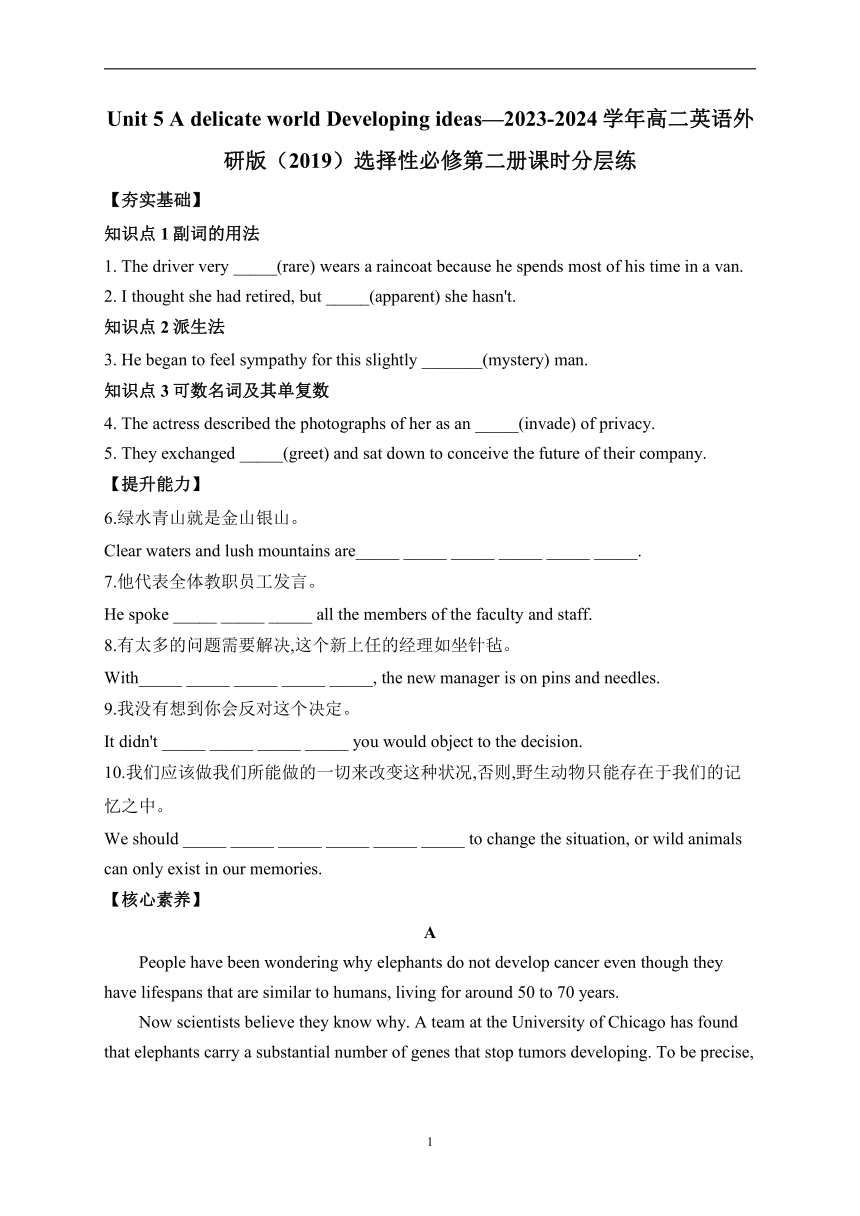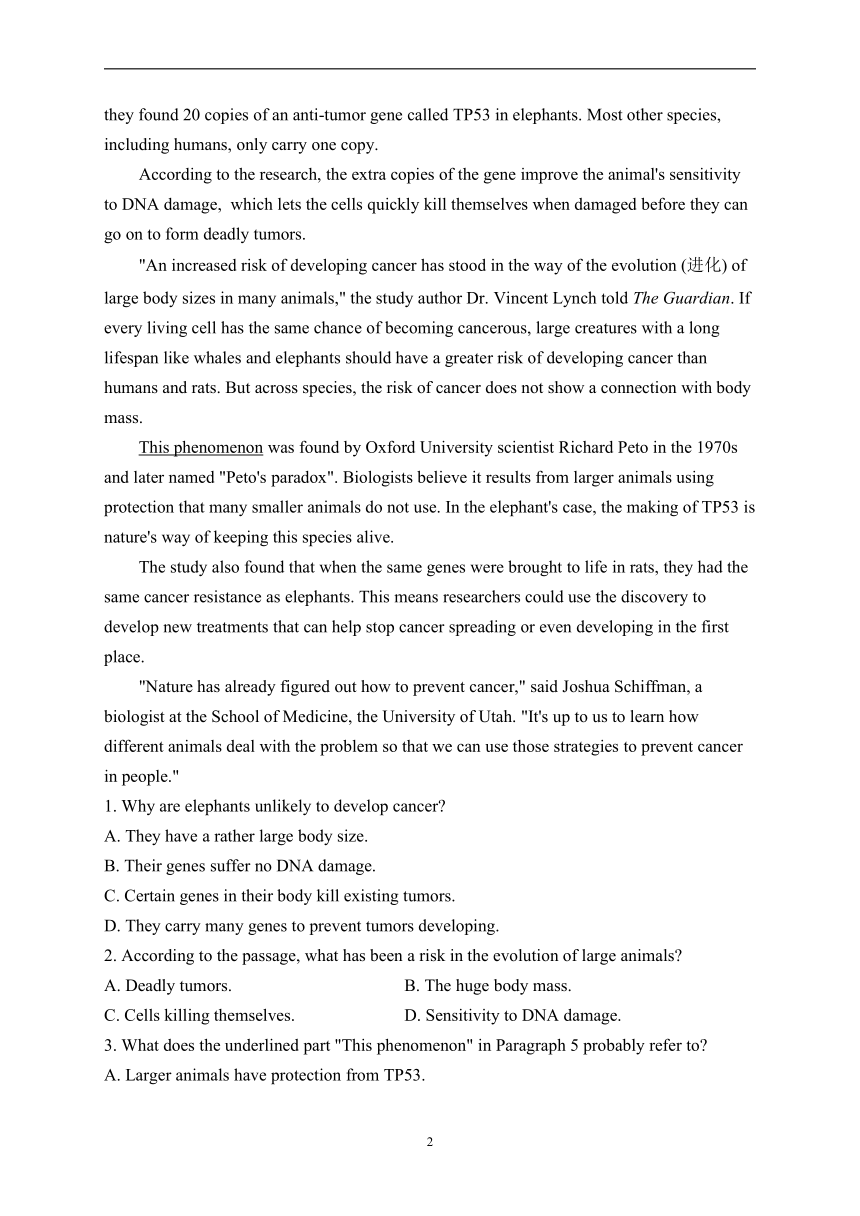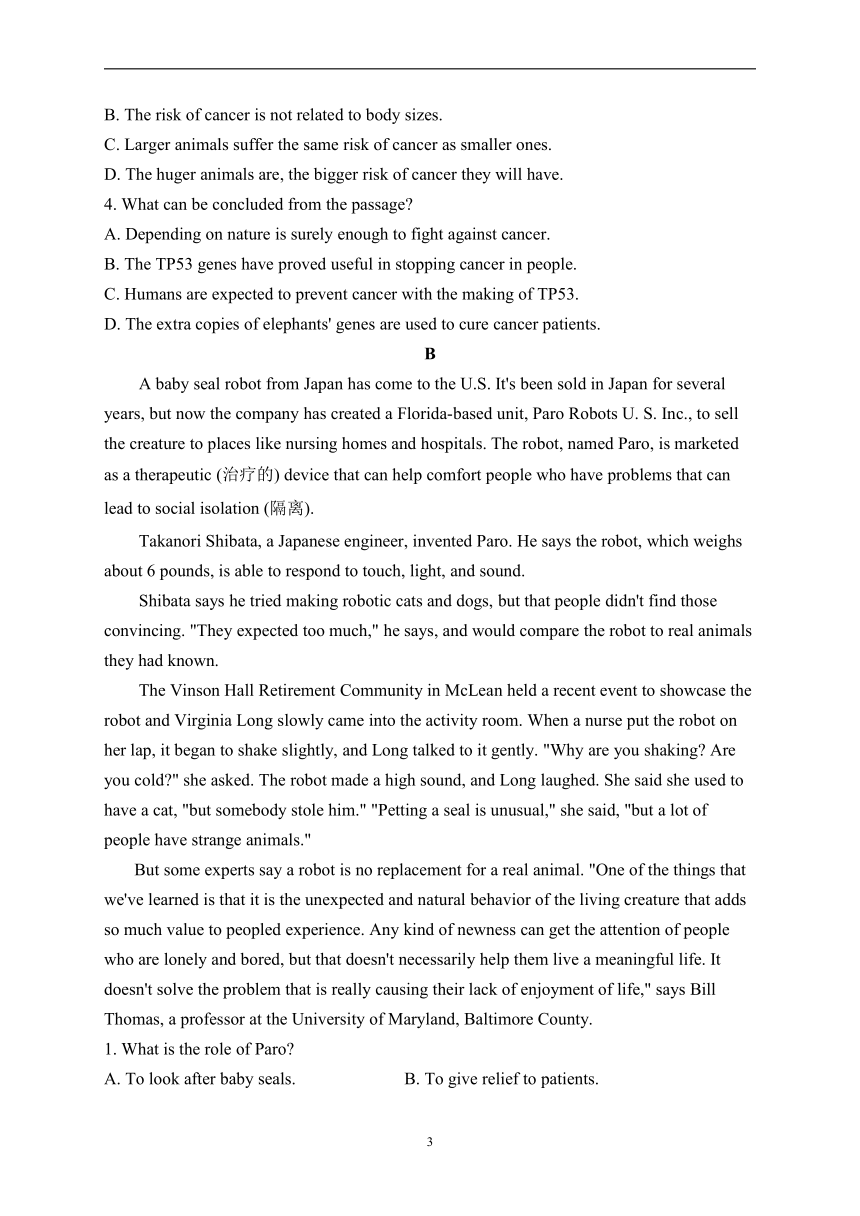外研版(2019)选择性必修第二册Unit 5 A delicate world Developing ideas课时分层练(含答案)
文档属性
| 名称 | 外研版(2019)选择性必修第二册Unit 5 A delicate world Developing ideas课时分层练(含答案) |  | |
| 格式 | docx | ||
| 文件大小 | 25.3KB | ||
| 资源类型 | 教案 | ||
| 版本资源 | 外研版(2019) | ||
| 科目 | 英语 | ||
| 更新时间 | 2023-09-04 16:48:49 | ||
图片预览



文档简介
Unit 5 A delicate world Developing ideas—2023-2024学年高二英语外研版(2019)选择性必修第二册课时分层练
【夯实基础】
知识点1副词的用法
1. The driver very _____(rare) wears a raincoat because he spends most of his time in a van.
2. I thought she had retired, but _____(apparent) she hasn't.
知识点2派生法
3. He began to feel sympathy for this slightly _______(mystery) man.
知识点3可数名词及其单复数
4. The actress described the photographs of her as an _____(invade) of privacy.
5. They exchanged _____(greet) and sat down to conceive the future of their company.
【提升能力】
6.绿水青山就是金山银山。
Clear waters and lush mountains are_____ _____ _____ _____ _____ _____.
7.他代表全体教职员工发言。
He spoke _____ _____ _____ all the members of the faculty and staff.
8.有太多的问题需要解决,这个新上任的经理如坐针毡。
With_____ _____ _____ _____ _____, the new manager is on pins and needles.
9.我没有想到你会反对这个决定。
It didn't _____ _____ _____ _____ you would object to the decision.
10.我们应该做我们所能做的一切来改变这种状况,否则,野生动物只能存在于我们的记忆之中。
We should _____ _____ _____ _____ _____ _____ to change the situation, or wild animals can only exist in our memories.
【核心素养】
A
People have been wondering why elephants do not develop cancer even though they have lifespans that are similar to humans, living for around 50 to 70 years.
Now scientists believe they know why. A team at the University of Chicago has found that elephants carry a substantial number of genes that stop tumors developing. To be precise, they found 20 copies of an anti-tumor gene called TP53 in elephants. Most other species, including humans, only carry one copy.
According to the research, the extra copies of the gene improve the animal's sensitivity to DNA damage, which lets the cells quickly kill themselves when damaged before they can go on to form deadly tumors.
"An increased risk of developing cancer has stood in the way of the evolution (进化) of large body sizes in many animals," the study author Dr. Vincent Lynch told The Guardian. If every living cell has the same chance of becoming cancerous, large creatures with a long lifespan like whales and elephants should have a greater risk of developing cancer than humans and rats. But across species, the risk of cancer does not show a connection with body mass.
This phenomenon was found by Oxford University scientist Richard Peto in the 1970s and later named "Peto's paradox". Biologists believe it results from larger animals using protection that many smaller animals do not use. In the elephant's case, the making of TP53 is nature's way of keeping this species alive.
The study also found that when the same genes were brought to life in rats, they had the same cancer resistance as elephants. This means researchers could use the discovery to develop new treatments that can help stop cancer spreading or even developing in the first place.
"Nature has already figured out how to prevent cancer," said Joshua Schiffman, a biologist at the School of Medicine, the University of Utah. "It's up to us to learn how different animals deal with the problem so that we can use those strategies to prevent cancer in people."
1. Why are elephants unlikely to develop cancer
A. They have a rather large body size.
B. Their genes suffer no DNA damage.
C. Certain genes in their body kill existing tumors.
D. They carry many genes to prevent tumors developing.
2. According to the passage, what has been a risk in the evolution of large animals
A. Deadly tumors. B. The huge body mass.
C. Cells killing themselves. D. Sensitivity to DNA damage.
3. What does the underlined part "This phenomenon" in Paragraph 5 probably refer to
A. Larger animals have protection from TP53.
B. The risk of cancer is not related to body sizes.
C. Larger animals suffer the same risk of cancer as smaller ones.
D. The huger animals are, the bigger risk of cancer they will have.
4. What can be concluded from the passage
A. Depending on nature is surely enough to fight against cancer.
B. The TP53 genes have proved useful in stopping cancer in people.
C. Humans are expected to prevent cancer with the making of TP53.
D. The extra copies of elephants' genes are used to cure cancer patients.
B
A baby seal robot from Japan has come to the U.S. It's been sold in Japan for several years, but now the company has created a Florida-based unit, Paro Robots U. S. Inc., to sell the creature to places like nursing homes and hospitals. The robot, named Paro, is marketed as a therapeutic (治疗的) device that can help comfort people who have problems that can lead to social isolation (隔离).
Takanori Shibata, a Japanese engineer, invented Paro. He says the robot, which weighs about 6 pounds, is able to respond to touch, light, and sound.
Shibata says he tried making robotic cats and dogs, but that people didn't find those convincing. "They expected too much," he says, and would compare the robot to real animals they had known.
The Vinson Hall Retirement Community in McLean held a recent event to showcase the robot and Virginia Long slowly came into the activity room. When a nurse put the robot on her lap, it began to shake slightly, and Long talked to it gently. "Why are you shaking Are you cold " she asked. The robot made a high sound, and Long laughed. She said she used to have a cat, "but somebody stole him." "Petting a seal is unusual," she said, "but a lot of people have strange animals."
But some experts say a robot is no replacement for a real animal. "One of the things that we've learned is that it is the unexpected and natural behavior of the living creature that adds so much value to peopled experience. Any kind of newness can get the attention of people who are lonely and bored, but that doesn't necessarily help them live a meaningful life. It doesn't solve the problem that is really causing their lack of enjoyment of life," says Bill Thomas, a professor at the University of Maryland, Baltimore County.
1. What is the role of Paro
A. To look after baby seals. B. To give relief to patients.
C. To replace home-raised pets. D. To provide medical examinations.
2. How did people feel about robotic cats
A. Disappointed. B. Astonished, C. Concerned. D. Amused.
3. What was Long's reaction to Paro
A. She refused to get close to it. B. She showed it much affection.
C. She regarded it as her new cat. D. She was frightened to talk to it.
4. What do Bill Thomas's words suggest about Paro
A. It is of great value to people. B. It is not of great use in solving real problems.
C. It fails to catch older people's interest. D. It can take the place of a living creature.
答案以及解析
【夯实基础】
1.答案:rarely
解析:句意:该司机极少穿雨衣,因为大部分时间他都是待在货车里。此处修饰谓语动词,在句中作状语,用副词形式。
2.答案:apparently
解析:句意:我原以为她退休了,但显然她还没有退。此处在句中作状语,用副词形式。
3.答案:mysterious
解析:考查形容词。句意:他开始对这位有点儿神秘的男子感到同情。形容词修饰名词,空处修饰名词man,故用形容词形式。
4.答案:invasion
解析:句意:那位女演员认为她的这些照片是对隐私权的侵犯。此处在冠词an后面,用可数名词的单数形式。
5.答案:greetings
解析:句意:他们互致问候,坐下来设想公司的未来。此处表示“问候”,用greetings。
【提升能力】
6.答案:as valuable as gold and silver
7.答案:on behalf of
8.答案:too many problems to solve
9.答案:occur to me that
10.答案:do everything that can be done
【核心素养】
A
答案:1-4.DABC
解析:1.细节理解题。根据第二段第二句A team at the University of Chicago has found that elephants carry a substantial number of genes that stop tumors developing.可知,美国芝加哥大学的一个团队发现大象携带大量阻止肿瘤发展的基因。根据第四段可知,动物形成癌症和动物的体型大小无关,故A项不正确;根据第三段中the extra copies of the gene improve the animal's sensitivity to DNA damage, which lets the cells quickly kill themselves when damaged before they can go on to form deadly tumors可知,大象的基因提高了对DNA损伤的敏感度,使细胞受损后,在形成致命肿瘤之前迅速自杀,并不是B项“大象的基因不会受到DNA损伤”;也不是C项“它们体内的某些基因会杀死现有的肿瘤”。所以D选项是正确的。
2.推理判断题。根据第四段第一句"An increased risk of developing cancer has stood in the way of the evolution(进化) of large body sizes in many animals," the study...可知,患癌症风险的增加阻碍了许多大体型的动物的进化。B项意为“巨大的体重”,在文中只提到其与增加患癌症的风险没有联系,而A项“致命的肿瘤”才是真正的风险;C项“细胞自杀”和D项“对DNA损坏的敏感度”都是动物保护自己不受癌症威胁的方式,不是风险。所以A选项是正确的。
3.推理判断题。根据第四段最后一句But across species, the risk of cancer does not show a connection with body mass.可知This phenomenon指的是物种患癌症的概率和它们的体重没有关系。A项“大型动物受到TP53的保护”和C项“大型动物患癌症的风险与小型动物相同”是画线部分以下内容,但不是画线部分的内容。D项“越大的动物,患癌症的风险就越大”不符合文章原意,且也不是本段开头所指的“这种现象”。所以B选项是正确的。
4.主旨大意题。根据最后一段最后一句It's up to us to learn how different animals deal with the problem so that we can use those strategies to prevent cancer in people.可知,我们可以使用那些策略来预防人类得癌症。而根据倒数第三段最后一句In the elephant's case, the making of TP53 is nature's way of keeping this species alive.可知,TP53的形成是让大象存活的自然方法。由此推知,人们有望通过合成TP53来预防癌症。人类需要制出TP53来对抗癌症,故A项“依靠大自然对抗癌症肯定足够了”不准确;文章倒数第二段只提到当同样的基因在老鼠身上起作用时,它们和大象具有相同的抗癌能力,但并未像B项所说“TP53基因已被证明在阻止人类得癌症方面很有用”或D项所说“大象基因的额外复制品被用于治疗癌症患者”。所以C选项是正确的。
B
答案:1-4 BABB
解析:1.细节理解题。根据第一段中的"The robot, named Paro, is marketed as a therapeutic (治疗的) device that can help comfort people who have problems that can lead to social isolation (隔离)."可知, 这款名为Paro的机器人被作为治疗性设备进行市场推广, 它可以帮助安慰那些有问题的人, 这些问题可能导致他们与社会隔离。由此可知Paro主要是为患者带来一丝慰藉。
2.推理判断题。根据第三段中的"Shibata says he tried making robotic cats and dogs...would compare the robot to real animals they had known." 可推断人们对机器猫比较失望, 因为他们总会将其与真猫作对比。
3.推理判断题。根据倒数第二段中的"When a nurse put the robot on her lap, it began to shake slightly, and Long talked to it gently. 'Why are you shaking Are you cold ' she asked. The robot made a high sound, and Long laughed." 可推断Long很喜欢Paro。
4.推理判断题。根据最后一段中的It doesn't solve the problem that is really causing their lack of enjoyment of life可推断Bill Thomas认为Paro虽然可以为孤独, 无聊的人带来快乐, 但是并不能真正解决他们生活中的问题。
2
【夯实基础】
知识点1副词的用法
1. The driver very _____(rare) wears a raincoat because he spends most of his time in a van.
2. I thought she had retired, but _____(apparent) she hasn't.
知识点2派生法
3. He began to feel sympathy for this slightly _______(mystery) man.
知识点3可数名词及其单复数
4. The actress described the photographs of her as an _____(invade) of privacy.
5. They exchanged _____(greet) and sat down to conceive the future of their company.
【提升能力】
6.绿水青山就是金山银山。
Clear waters and lush mountains are_____ _____ _____ _____ _____ _____.
7.他代表全体教职员工发言。
He spoke _____ _____ _____ all the members of the faculty and staff.
8.有太多的问题需要解决,这个新上任的经理如坐针毡。
With_____ _____ _____ _____ _____, the new manager is on pins and needles.
9.我没有想到你会反对这个决定。
It didn't _____ _____ _____ _____ you would object to the decision.
10.我们应该做我们所能做的一切来改变这种状况,否则,野生动物只能存在于我们的记忆之中。
We should _____ _____ _____ _____ _____ _____ to change the situation, or wild animals can only exist in our memories.
【核心素养】
A
People have been wondering why elephants do not develop cancer even though they have lifespans that are similar to humans, living for around 50 to 70 years.
Now scientists believe they know why. A team at the University of Chicago has found that elephants carry a substantial number of genes that stop tumors developing. To be precise, they found 20 copies of an anti-tumor gene called TP53 in elephants. Most other species, including humans, only carry one copy.
According to the research, the extra copies of the gene improve the animal's sensitivity to DNA damage, which lets the cells quickly kill themselves when damaged before they can go on to form deadly tumors.
"An increased risk of developing cancer has stood in the way of the evolution (进化) of large body sizes in many animals," the study author Dr. Vincent Lynch told The Guardian. If every living cell has the same chance of becoming cancerous, large creatures with a long lifespan like whales and elephants should have a greater risk of developing cancer than humans and rats. But across species, the risk of cancer does not show a connection with body mass.
This phenomenon was found by Oxford University scientist Richard Peto in the 1970s and later named "Peto's paradox". Biologists believe it results from larger animals using protection that many smaller animals do not use. In the elephant's case, the making of TP53 is nature's way of keeping this species alive.
The study also found that when the same genes were brought to life in rats, they had the same cancer resistance as elephants. This means researchers could use the discovery to develop new treatments that can help stop cancer spreading or even developing in the first place.
"Nature has already figured out how to prevent cancer," said Joshua Schiffman, a biologist at the School of Medicine, the University of Utah. "It's up to us to learn how different animals deal with the problem so that we can use those strategies to prevent cancer in people."
1. Why are elephants unlikely to develop cancer
A. They have a rather large body size.
B. Their genes suffer no DNA damage.
C. Certain genes in their body kill existing tumors.
D. They carry many genes to prevent tumors developing.
2. According to the passage, what has been a risk in the evolution of large animals
A. Deadly tumors. B. The huge body mass.
C. Cells killing themselves. D. Sensitivity to DNA damage.
3. What does the underlined part "This phenomenon" in Paragraph 5 probably refer to
A. Larger animals have protection from TP53.
B. The risk of cancer is not related to body sizes.
C. Larger animals suffer the same risk of cancer as smaller ones.
D. The huger animals are, the bigger risk of cancer they will have.
4. What can be concluded from the passage
A. Depending on nature is surely enough to fight against cancer.
B. The TP53 genes have proved useful in stopping cancer in people.
C. Humans are expected to prevent cancer with the making of TP53.
D. The extra copies of elephants' genes are used to cure cancer patients.
B
A baby seal robot from Japan has come to the U.S. It's been sold in Japan for several years, but now the company has created a Florida-based unit, Paro Robots U. S. Inc., to sell the creature to places like nursing homes and hospitals. The robot, named Paro, is marketed as a therapeutic (治疗的) device that can help comfort people who have problems that can lead to social isolation (隔离).
Takanori Shibata, a Japanese engineer, invented Paro. He says the robot, which weighs about 6 pounds, is able to respond to touch, light, and sound.
Shibata says he tried making robotic cats and dogs, but that people didn't find those convincing. "They expected too much," he says, and would compare the robot to real animals they had known.
The Vinson Hall Retirement Community in McLean held a recent event to showcase the robot and Virginia Long slowly came into the activity room. When a nurse put the robot on her lap, it began to shake slightly, and Long talked to it gently. "Why are you shaking Are you cold " she asked. The robot made a high sound, and Long laughed. She said she used to have a cat, "but somebody stole him." "Petting a seal is unusual," she said, "but a lot of people have strange animals."
But some experts say a robot is no replacement for a real animal. "One of the things that we've learned is that it is the unexpected and natural behavior of the living creature that adds so much value to peopled experience. Any kind of newness can get the attention of people who are lonely and bored, but that doesn't necessarily help them live a meaningful life. It doesn't solve the problem that is really causing their lack of enjoyment of life," says Bill Thomas, a professor at the University of Maryland, Baltimore County.
1. What is the role of Paro
A. To look after baby seals. B. To give relief to patients.
C. To replace home-raised pets. D. To provide medical examinations.
2. How did people feel about robotic cats
A. Disappointed. B. Astonished, C. Concerned. D. Amused.
3. What was Long's reaction to Paro
A. She refused to get close to it. B. She showed it much affection.
C. She regarded it as her new cat. D. She was frightened to talk to it.
4. What do Bill Thomas's words suggest about Paro
A. It is of great value to people. B. It is not of great use in solving real problems.
C. It fails to catch older people's interest. D. It can take the place of a living creature.
答案以及解析
【夯实基础】
1.答案:rarely
解析:句意:该司机极少穿雨衣,因为大部分时间他都是待在货车里。此处修饰谓语动词,在句中作状语,用副词形式。
2.答案:apparently
解析:句意:我原以为她退休了,但显然她还没有退。此处在句中作状语,用副词形式。
3.答案:mysterious
解析:考查形容词。句意:他开始对这位有点儿神秘的男子感到同情。形容词修饰名词,空处修饰名词man,故用形容词形式。
4.答案:invasion
解析:句意:那位女演员认为她的这些照片是对隐私权的侵犯。此处在冠词an后面,用可数名词的单数形式。
5.答案:greetings
解析:句意:他们互致问候,坐下来设想公司的未来。此处表示“问候”,用greetings。
【提升能力】
6.答案:as valuable as gold and silver
7.答案:on behalf of
8.答案:too many problems to solve
9.答案:occur to me that
10.答案:do everything that can be done
【核心素养】
A
答案:1-4.DABC
解析:1.细节理解题。根据第二段第二句A team at the University of Chicago has found that elephants carry a substantial number of genes that stop tumors developing.可知,美国芝加哥大学的一个团队发现大象携带大量阻止肿瘤发展的基因。根据第四段可知,动物形成癌症和动物的体型大小无关,故A项不正确;根据第三段中the extra copies of the gene improve the animal's sensitivity to DNA damage, which lets the cells quickly kill themselves when damaged before they can go on to form deadly tumors可知,大象的基因提高了对DNA损伤的敏感度,使细胞受损后,在形成致命肿瘤之前迅速自杀,并不是B项“大象的基因不会受到DNA损伤”;也不是C项“它们体内的某些基因会杀死现有的肿瘤”。所以D选项是正确的。
2.推理判断题。根据第四段第一句"An increased risk of developing cancer has stood in the way of the evolution(进化) of large body sizes in many animals," the study...可知,患癌症风险的增加阻碍了许多大体型的动物的进化。B项意为“巨大的体重”,在文中只提到其与增加患癌症的风险没有联系,而A项“致命的肿瘤”才是真正的风险;C项“细胞自杀”和D项“对DNA损坏的敏感度”都是动物保护自己不受癌症威胁的方式,不是风险。所以A选项是正确的。
3.推理判断题。根据第四段最后一句But across species, the risk of cancer does not show a connection with body mass.可知This phenomenon指的是物种患癌症的概率和它们的体重没有关系。A项“大型动物受到TP53的保护”和C项“大型动物患癌症的风险与小型动物相同”是画线部分以下内容,但不是画线部分的内容。D项“越大的动物,患癌症的风险就越大”不符合文章原意,且也不是本段开头所指的“这种现象”。所以B选项是正确的。
4.主旨大意题。根据最后一段最后一句It's up to us to learn how different animals deal with the problem so that we can use those strategies to prevent cancer in people.可知,我们可以使用那些策略来预防人类得癌症。而根据倒数第三段最后一句In the elephant's case, the making of TP53 is nature's way of keeping this species alive.可知,TP53的形成是让大象存活的自然方法。由此推知,人们有望通过合成TP53来预防癌症。人类需要制出TP53来对抗癌症,故A项“依靠大自然对抗癌症肯定足够了”不准确;文章倒数第二段只提到当同样的基因在老鼠身上起作用时,它们和大象具有相同的抗癌能力,但并未像B项所说“TP53基因已被证明在阻止人类得癌症方面很有用”或D项所说“大象基因的额外复制品被用于治疗癌症患者”。所以C选项是正确的。
B
答案:1-4 BABB
解析:1.细节理解题。根据第一段中的"The robot, named Paro, is marketed as a therapeutic (治疗的) device that can help comfort people who have problems that can lead to social isolation (隔离)."可知, 这款名为Paro的机器人被作为治疗性设备进行市场推广, 它可以帮助安慰那些有问题的人, 这些问题可能导致他们与社会隔离。由此可知Paro主要是为患者带来一丝慰藉。
2.推理判断题。根据第三段中的"Shibata says he tried making robotic cats and dogs...would compare the robot to real animals they had known." 可推断人们对机器猫比较失望, 因为他们总会将其与真猫作对比。
3.推理判断题。根据倒数第二段中的"When a nurse put the robot on her lap, it began to shake slightly, and Long talked to it gently. 'Why are you shaking Are you cold ' she asked. The robot made a high sound, and Long laughed." 可推断Long很喜欢Paro。
4.推理判断题。根据最后一段中的It doesn't solve the problem that is really causing their lack of enjoyment of life可推断Bill Thomas认为Paro虽然可以为孤独, 无聊的人带来快乐, 但是并不能真正解决他们生活中的问题。
2
